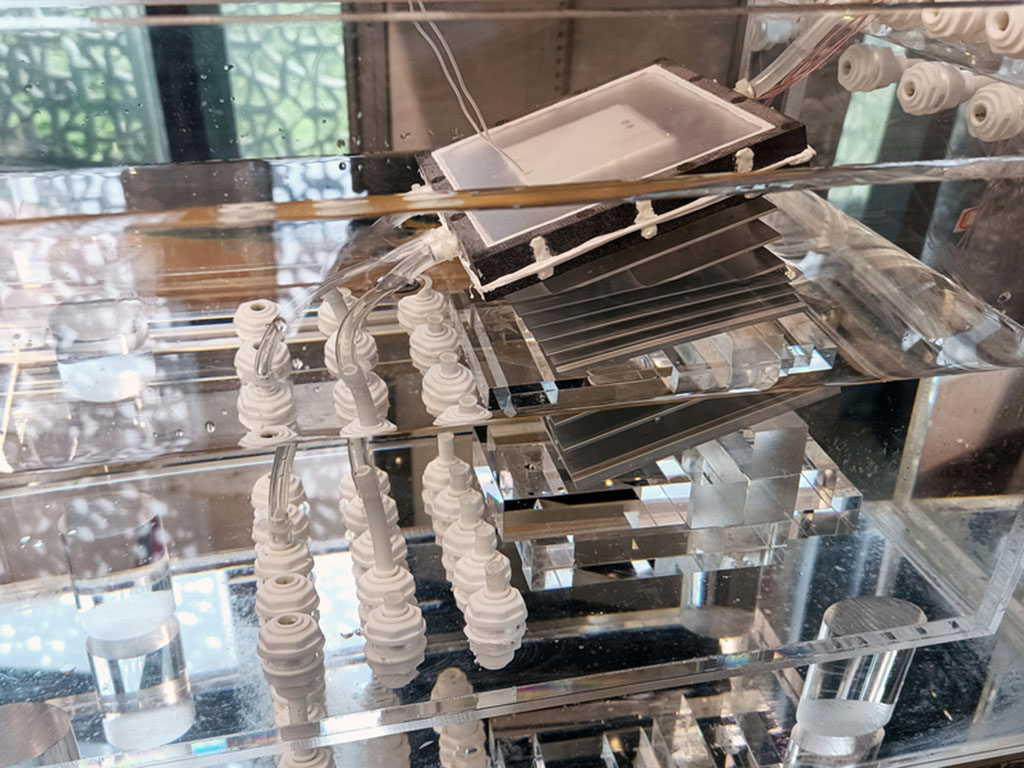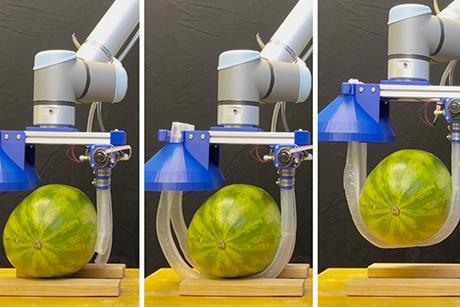Desalination system could produce freshwater that is cheaper than tap water
Engineers at MIT and in China are aiming to turn seawater into drinking water with a completely passive device that is inspired by the ocean, and powered by the sun.
In a paper appearing today in the journal Joule, the team outlines the design for a new solar desalination system that takes in saltwater and heats it with natural sunlight.
The configuration of the device allows water to circulate in swirling eddies, in a manner similar to the much larger “thermohaline” circulation of the ocean. This circulation, combined with the sun’s heat, drives water to evaporate, leaving salt behind. The resulting water vapor can then be condensed and collected as pure, drinkable water. In the meantime, the leftover salt continues to circulate through and out of the device, rather than accumulating and clogging the system.
The new system has a higher water-production rate and a higher salt-rejection rate than all other passive solar desalination concepts currently being tested.
The researchers estimate that if the system is scaled up to the size of a small suitcase, it could produce about 4 to 6 liters of drinking water per hour and last several years before requiring replacement parts. At this scale and performance, the system could produce drinking water at a rate and price that is cheaper than tap water.
“For the first time, it is possible for water, produced by sunlight, to be even cheaper than tap water,” says Lenan Zhang, a research scientist in MIT’s Device Research Laboratory.
The team envisions a scaled-up device could passively produce enough drinking water to meet the daily requirements of a small family. The system could also supply off-grid, coastal communities where seawater is easily accessible.
Zhang’s study co-authors include MIT graduate student Yang Zhong and Evelyn Wang, the Ford Professor of Engineering, along with Jintong Gao, Jinfang You, Zhanyu Ye, Ruzhu Wang, and Zhenyuan Xu of Shanghai Jiao Tong University in China.
A powerful convection
The team’s new system improves on their previous design — a similar concept of multiple layers, called stages. Each stage contained an evaporator and a condenser that used heat from the sun to passively separate salt from incoming water. That design, which the team tested on the roof of an MIT building, efficiently converted the sun’s energy to evaporate water, which was then condensed into drinkable water. But the salt that was left over quickly accumulated as crystals that clogged the system after a few days. In a real-world setting, a user would have to place stages on a frequent basis, which would significantly increase the system’s overall cost.
In a follow-up effort, they devised a solution with a similar layered configuration, this time with an added feature that helped to circulate the incoming water as well as any leftover salt. While this design prevented salt from settling and accumulating on the device, it desalinated water at a relatively low rate.
In the latest iteration, the team believes it has landed on a design that achieves both a high water-production rate, and high salt rejection, meaning that the system can quickly and reliably produce drinking water for an extended period. The key to their new design is a combination of their two previous concepts: a multistage system of evaporators and condensers, that is also configured to boost the circulation of water — and salt — within each stage.
“We introduce now an even more powerful convection, that is similar to what we typically see in the ocean, at kilometer-long scales,” Xu says.
The small circulations generated in the team’s new system is similar to the “thermohaline” convection in the ocean — a phenomenon that drives the movement of water around the world, based on differences in sea temperature (“thermo”) and salinity (“haline”).
“When seawater is exposed to air, sunlight drives water to evaporate. Once water leaves the surface, salt remains. And the higher the salt concentration, the denser the liquid, and this heavier water wants to flow downward,” Zhang explains. “By mimicking this kilometer-wide phenomena in small box, we can take advantage of this feature to reject salt.”
Tapping out
The heart of the team’s new design is a single stage that resembles a thin box, topped with a dark material that efficiently absorbs the heat of the sun. Inside, the box is separated into a top and bottom section. Water can flow through the top half, where the ceiling is lined with an evaporator layer that uses the sun’s heat to warm up and evaporate any water in direct contact. The water vapor is then funneled to the bottom half of the box, where a condensing layer air-cools the vapor into salt-free, drinkable liquid. The researchers set the entire box at a tilt within a larger, empty vessel, then attached a tube from the top half of the box down through the bottom of the vessel, and floated the vessel in saltwater.
In this configuration, water can naturally push up through the tube and into the box, where the tilt of the box, combined with the thermal energy from the sun, induces the water to swirl as it flows through. The small eddies help to bring water in contact with the upper evaporating layer while keeping salt circulating, rather than settling and clogging.
The team built several prototypes, with one, three, and 10 stages, and tested their performance in water of varying salinity, including natural seawater and water that was seven times saltier.
From these tests, the researchers calculated that if each stage were scaled up to a square meter, it would produce up to 5 liters of drinking water per hour, and that the system could desalinate water without accumulating salt for several years. Given this extended lifetime, and the fact that the system is entirely passive, requiring no electricity to run, the team estimates that the overall cost of running the system would be cheaper than what it costs to produce tap water in the United States.
“We show that this device is capable of achieving a long lifetime,” Zhong says. “That means that, for the first time, it is possible for drinking water produced by sunlight to be cheaper than tap water. This opens up the possibility for solar desalination to address real-world problems.”
“This is a very innovative approach that effectively mitigates key challenges in the field of desalination,” says Guihua Yu, who develops sustainable water and energy storage systems at the University of Texas at Austin, and was not involved in the research. “The design is particularly beneficial for regions struggling with high-salinity water. Its modular design makes it highly suitable for household water production, allowing for scalability and adaptability to meet individual needs.”
Funding for the research at Shanghai Jiao Tong University was supported by the Natural Science Foundation of China.



